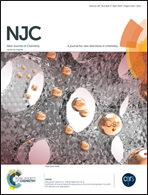Targeting copper induced oxidative damage to proteins by ligation: a novel approach towards chelation therapy for oxidative stress disorders
Abstract
Oxidative stress due to excessive accumulation of reactive oxygen species (ROS) triggers the onset of various pathological conditions in humans such as cancer, arthritis, muscular dystrophy (MD), Alzheimer's and Parkinson's diseases. To date, the available therapeutic strategies have mainly focused on removal or sequestering of excessive ROS rather than preventing their generation. In the present study we hypothesize that the selective ligation of copper and iron ions in their inactive redox states with appropriate ligands can be a novel approach for prevention of free radical generation. To testify this hypothesis the present study was devised to explore the structural, conformational and electronic requirements of a potential biocompatible inhibitor of copper induced oxidative damage to proteins. A series of chemical compounds such as neocuproine, bathophenanthroline, thiourea, acetonitrile, bathocuproine, dimethylsulfoxide, mannitol, urea and histidine were tested for their impact on copper induced oxidative damage to proteins. To measure the oxidative damage, bovine serum albumin (BSA) was used as the model substrate to quantitate the conversion of its free amino groups to the carbonyl counterparts under the ROS induced oxidative stress. The observed complexation behavior of Cu with the investigated ligands revealed that a ligand with soft donor sites, donor sites placed at the corners of a tetrahedron or a good π-back acceptance character shall exhibit excellent potential to inhibit copper induced oxidative damage to proteins. To validate these facts we tested two bioactive molecules viz. 1,2-(diimino-4′-antipyrinyl)-1,2-diphenyl ethane (DIDE) and rhodanine whose distinctive molecular structure meets the hypothesized prerequisites, for their protective impact against Cu induced free radical-mediated oxidative damage. Expectedly both DIDE and rhodanine were found to offer excellent protection against copper-catalyzed oxidative damage to BSA. Furthermore, based on the thermodynamic, kinetic and computational investigations, we propose that the observed antioxidant activity of DIDE and rhodanine is due to the selective stabilization of Cu(I) by these bioactive and biofriendly molecules. To the best of our knowledge, the present study is the first of its kind to establish that the antioxidant activity of DIDE and rhodanine is an outcome of their ability to reduce the generation of ROS by binding copper into a redox inactive form.


 Please wait while we load your content...
Please wait while we load your content...